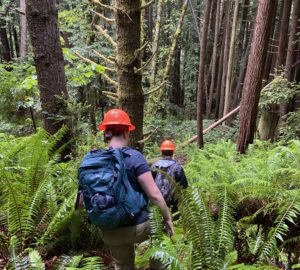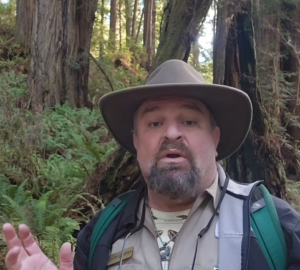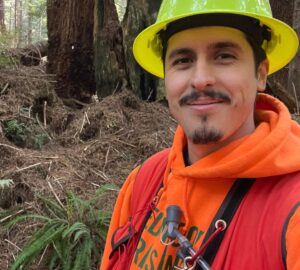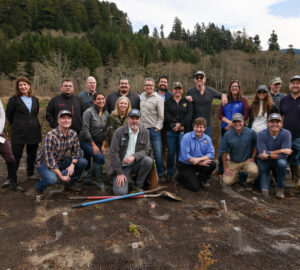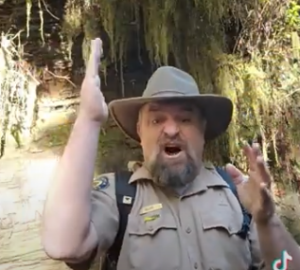While nearly half of the world’s protected ancient coast redwoods stand today within Redwood National and State Parks, as a whole, these parks are far from pristine. Here in this forest, about two-thirds of the redwoods were logged before the parks formed, and it will take many generations for the forest to recover.
Together with the National Park Service and California State Parks, Save the Redwoods League has embarked on an unprecedented effort to accelerate the pace of recovery in the formerly logged areas of the parks and protect the area’s remaining old-growth groves through a program known as Redwoods Rising. And, for a second year in a row, we’re working with Humboldt State University (HSU) to train the next generation of conservation leaders.
This summer, HSU hired eighteen students as Redwoods Rising summer apprentices. Guided by the forestry faculty Erin Kelly, who is also a League Councilor, and Lucy Kerhoulas, the apprentices will gain hands-on experience, collecting data in forestry, botany, wildlife, hydrology, and watershed rehabilitation. The information they gather is in preparation for and directly supporting future work on the ground. This experience will complement and augment their classroom instruction as they apply their learning and work alongside forestry professionals that are actively rehabilitating the forest across the redwood parks.
We’re thrilled to work with these students this summer, and invite you to read more about these remarkable apprentices below.
Meet the Redwoods Rising Apprentices from Humboldt State University
Summer 2019
Forestry Apprentices
Forestry Apprentices are working alongside National Park Service and California State Parks staff to prepare previously-harvested stands in Del Norte Redwoods State Park, Prairie Creek State Park, and Redwood National Park for restoration thinning. They are marking trees, flagging boundaries, establishing baselines, and delineating monitoring plots.
Ryann Howard
Major: Forestry – Restoration
I stand tall with Redwoods Rising because I recognize it as an excellent opportunity to become involved in natural resource programs that offer work and scientific experience. It is important to me to return these fragmented ecosystems back to health and their natural ability to resist harmful impacts of drought, fire, disease, invasive species, and climate change.
Dillon Martin
Major: Forestry – Restoration
I am happiest when I am learning, working, or hiking in the great outdoors. My enthusiasm for this work is bar none — I wake up every day with unrivaled excitement, knowing that I get to help make our world more sustainable.
Cameron Miller
Major: Forestry
I am passionate about learning all I can about California’s forestlands and forestry as a discipline. I am excited about the chance to meet and work with others who share this passion and to learn from true experts in forestry and ecology.
Caleb Van Rossum
Major: Forestry – Hydrology
I’m looking forward to putting everything I learned last semester into action. There seems to be a wealth of knowledge available through this apprenticeship that I will be able to utilize throughout my career. Plus, there’s just something about being in the redwood forest that rejuvenates me.
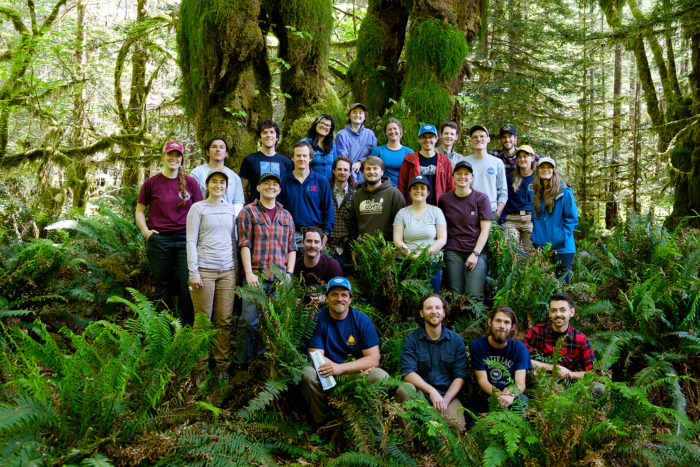
Rare Plants Apprentices
Rare Plants Apprentices are identifying, geolocating, and flagging off populations of rare plants along roads that were previously used for hauling logs, prior to Redwood National and State Park management, and in areas of the park where trees have grown back densely, where underbrush and species diversity is suppressed and the forest provides little habitat diversity. The legacy road features are being re-used by Redwoods Rising to access restoration areas and will be removed upon completion of restoration actions, and the apprentices will ensure that sensitive plant populations are not negatively affected.
Caitlyn Allchin
Major: Botany
I want to gain the experience and knowledge necessary to contribute to a more stable ecosystem and to improve our local environment to be more resilient to external factors such as fires, pollution, and human exploitation.
Macy Budesilich
Major: Botany
Not only is this an amazing opportunity to work toward cleaning the forest of invasives and protecting our rare native plant species, but it’s a great platform for personal growth. I strongly believe in the reforestation of our redwoods and protecting our environment. This opportunity is a gateway for my future career of wanting to work for the Forest Service.
Skylr Lopez
Major: Wildlife Biology
I have been aching to get involved in restoration projects because I know how important they are to the management of habitats and overall ecosystem health. Teamwork is something I really enjoy, and science is a field where when more people come together, great results can be produced.
Julia Martinez
Major: Botany
This experience has exactly what I desire in working in the field of botany and learning more about methods of restoration that I can use in the future as a field botanist. I understand the importance of fieldwork and completing the tasks we’re given to help learn and assist or improve the environment for future generations.
Exotics Management Apprentices
This year, the Exotics Management Apprentices are protecting our parks from the influence of exotic plant species by combating infestations as they start. Exotic plants are plants that were introduced to an area where they otherwise would not exist. Because these plants exist outside of their native ecosystem, they do not experience checks such as predation, grazing, and climatic influences that would usually help control populations. This allows non-native species like pampas grass and English Ivy to grow very aggressively and displace or possibly extirpate native plants. Using California State Park’s Early Detection Rapid Response Protocol, apprentices are geolocating populations of exotic plant species and removing small infestations along the extensive legacy road network in the Mill Creek Acquisition.
Judson Fisher
Major: Forestry
This is a very special opportunity to be a part of a richly collaborative project working towards a noble goal locally with the prospect of learning new skills — and being paid for it! Moving forward, collaborative projects like this are the best model to affect ecologically sound land management, a process which it is my career goal to be a part of.
Christopher Villarruel
Major: Forestry – Hydrology
My greatest strengths come in the way of my love for being outdoors, my computer abilities, and the tribal cultural knowledge that I bring with me when I work on something. I love being outdoors and feel that it gives me an appreciation for natural resource-related work. It is an honor to work in the ancestral home lands of the Tolowa people.
Wildlife Apprentices
Wildlife Apprentices are assisting park staff with surveys of Humboldt marten (endangered under the California Endangered Species Act), foothill yellow-legged frogs (California Department of Fish & Wildlife Species of Special Concern), and northern spotted owls (endangered under the federal Endangered Species Act).
Christopher Collier
Major: Wildlife Biology – Conservation Biology/Applied Vertebrate Ecology
On a family road trip as a teenager, I remember passing through Humboldt County in awe of the magnificent redwoods towering above my head. This opportunity with Save the Redwoods League will allow me to continue to learn and develop my skills as a wildlife biologist. It thrills me to see a landscape-level program like this flourishing.
Ryan Thompson
Major: Wildlife Biology
This season’s wildlife apprenticeship has me very excited, as it has always been a dream of mine to work with owls. Working another season for Redwoods Rising will also strengthen my botany experience and give me the opportunity to establish myself in the wildlife field with relevant experience and new connections.
Watershed Rehabilitation Apprentices
In Prairie Creek Redwoods State Park, Watershed Rehabilitation Apprentices are reading the landscape with the help of historic aerial photos to identify legacy road features left on the previously logged landscape hidden to the untrained eye. And at Del Norte Coast Redwoods State Park and Redwood National Park, apprentices are surveying many of the 500+ culverts that serve as plumbing for the vast legacy road network in this previously logged landscape.
Anton Bokisch
Major: Environmental Science & Management and Ecological Restoration
I’ve always had a love for nature and love spending time outside, and I want to work in the redwoods and meet other people who are interested in restoration. It would be amazing to work in these areas that I frequently visit. This is a great step closer to a career in ecological restoration.
Steven Hopper
Major: Environmental Resources Engineering
I want to work outdoors with hydrological and ecological systems for the betterment of the natural world. I love Humboldt County, and I would like to spend my time contributing to this project’s lasting benefits and learning from all that the redwood curtain has to offer.
Haley Isaacson
Major: Environmental Resources Engineering
I am passionate about natural remediation techniques. I believe we, as humankind, have a responsibility to native people, plants, and animals to use our knowledge and technology to help return the land to its original state. I plan to spend my life working with others to this end.
Samantha Bowman Pincus
Major: Forestry – Wildland Fire Management
This opportunity will help jump-start my ideal career in forestry, giving me the opportunity to practice field surveying, summarize and present data, and make crucial connections with a well-known non-profit organization. I would love the chance to get familiar with state and federal operations and contribute to such a large project that I believe in.
Hydrology Apprentices
Hydrology Apprentices are classifying streams to help guide streamside protections for restoration thinning prescriptions. A stream inventory this extensive has never been attempted in the Mill Creek and Rock Creek watersheds.
Brett Crandall
Major: Forestry – Hydrology
Being able to work outdoors towards sustainable management and restoration practices is a career goal of mine. Working for Save the Redwoods League will allow me to gain hands-on restoration experience in areas that I frequently enjoy and visit while working to protect and foster ecosystem health.
Sarah McGee
Major: Forestry – Soils
I have a passion for the outdoors, specifically soils, botany, and forestry. This job means the world to me not only to be able to spend the summer immersed in something I love but also getting the field experience that I need for my career. I am excited to make a difference in the places I love to go hiking and fishing every weekend.
Learn more about the League’s restoration programs, including Redwoods Rising.



